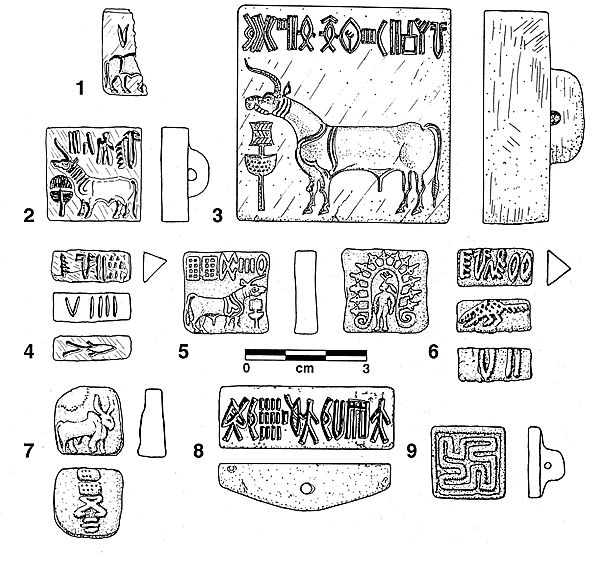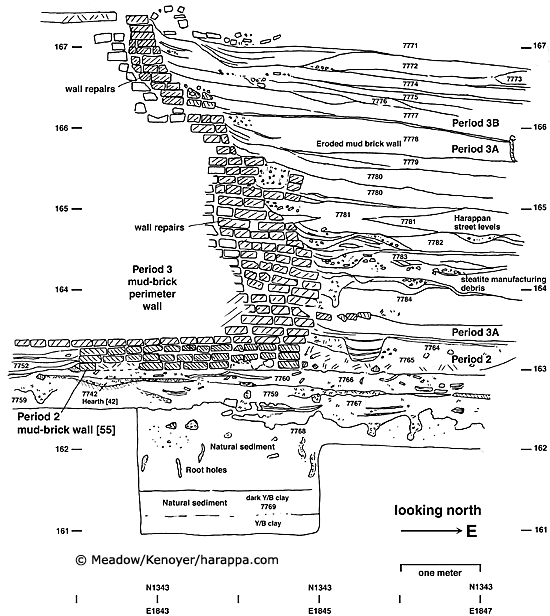Harappa Phase Occupation: Chronology and Fortification Wall
Since 1986, excavations of the Harappa Phase occupations (2600-1900 BCE), have been conducted on all of the major mounds and in low lying areas between the mounds and along their peripheries (Figure 1). On the basis of these studies, it is possible to determine the overall size of the city at over 150 hectares and the size of the separate walled areas range from 10 to 25 hectares each. Three subphases can be defined based on major rebuilding phases of the city walls, changing artifact and pottery styles, and changes in styles of seals (Figure 4).

Figure 4: Harappan Seal Styles
1. H90-1600/3166-01: Steatite seal, Period 3A.
2. H95-2491/4690-01: Steatite seal, Period 3B.
3. H99-4064/8796-01: Steatite seal, Period 3C.
4. H95-2482/4419-05: Incised steatite tablet, Period 3B/3C.
5. H95-2485/5719-02: Molded terracotta tablet, Period 3B/3C.
6. H94-2177/4999-01: Molded faience tablet, Period 3B/3C.
7. H94-2184/4999-216: Molded faience tablet, 3B/3C.
8. H98-3491/8322-21: Steatite seal, Mound AB, Period 3C.
9. H99-3814/8756-01: Button seal, molded faience, Period 3C.
Figure 5. Harappa 1997, Mound AB, Trench 42, Wheeler¹s Fortification Wall.
Figure 6. Harappa 1999, Mound F, Trench 41, southeast corner of the "Great Granary" or "Great Hall".
Figure 7. Harappa 1999, Mound F, Trench 41: southeast corner of the "Great Granary" or "Great Hall."
Figure 8. Harappa 1998, Mound F, Trench 43: A) plan view of circular platforms; B) section of sediments above platform [22] and section through central pit.
Figure 9. Harappa 1999, Mound F, Trench 43: Period 5 kiln, plan and section views.
For example, the characteristic square steatite seals with animal motifs and short inscriptions begins in late Period 2 as noted above, is found in 3A and continues into Period 3C, but the carving style for both the animal motifs, and the inscriptions shows stylistic changes. The greatest variation and widespread use of such seals appears to be during Period 3B. Small rectangular inscribed tablets made from steatite begin to appear at the beginning of Period 3B and by the end of 3B there is a wide variety of tiny tablets in many different shapes and materials. They were made of fired steatite or of molded terracotta or faience. Some of the steatite tablets were decorated with red pigment and the faience tablets were covered with a thick blue-green glaze. These various forms of inscribed tablets continued on into Period 3C where we also find evidence for copper tablets all bearing the same raised inscription. The copper tablets at Mohenjo-daro are incised and have several variations in terms of animal motifs on one side and inscriptions on the opposite side. Rectangular steatite seals with inscription only, glazed faience geometric seals, and stamped pottery (exclusively pointed-base or Indus goblets), appear to have been used only in Period 3C.
Beginning in 1997, selective excavations have served to clarify the chronology and function of some of the most famous structures at the site. These include the Mound AB "fortification walls," the Mound F "Circular Platforms," and the "Great Granary" (Meadow, Kenoyer and Wright 1998; Meadow, Kenoyer and Wright 1999; Meadow, Kenoyer and Wright 2000).
Fortification Wall
The fortification walls of Harappa were first defined by Wheeler in 1946 (wheeler 1947) and one of the most impressive excavations of the city walls was in Trench XXX. This well known trench is where he noted the presence of an "alien culture" from beneath the city walls. These cultural deposits were later identified by M. R. Mughal (1970) as belonging to the Early Harappan or Kot Diji Phase, and he also suggested that the lower portion of the inner part of the huge perimeter ("fortification") wall might be Early Harappan in date.

Figure 5: Harappa 1997, Mound AB, Trench 42, Wheeler's Fortification Wall
A reexamination of this trench in 1997 and 1998 determined that indeed there was a substantial Early Harappan occupation deposit with hearths, stone tools figurines, and lots of pottery. An Early Harappan wall was also identified, but it was below the area designated by both Wheeler and Mughal (Figure 5). The Harappan phase wall was actually built on top of the Early Harappan city wall. Careful examination of the Harappan wall construction and sampling of sherds found in the mortar revealed that it was built up and refaced both inside and outside numerous times during the c. 700 years of the Harappan phase occupation (Meadow, Kenoyer and Wright 1997).
Against the eastern (inside) face of the wall is a long sequence of Harappan deposits that include early street levels filled with pottery and steatite bead workshop debris. The earliest street layers date to Period 3A and there is a continuous sequence through Period 3B and 3C. In the uppermost levels, Cemetery H pottery of Period 4/5 was recovered along with large quantities of charred grain was associated with a burned storage bin made of wattle and daub.
{Reprinted by permission from: Meadow, R.H. and J.M. Kenoyer (2001) Recent discoveries and highlights from excavations at Harappa: 1998-2000. INDO-KOKO-KENKYU [Indian Archaeological Studies] 22: 19-36.}
